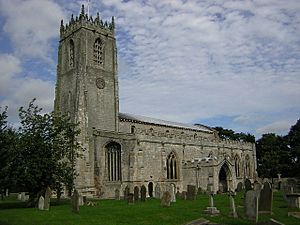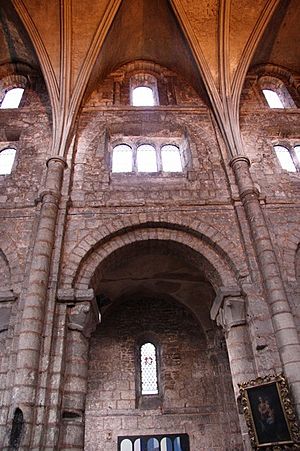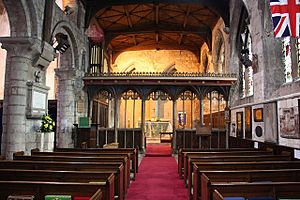St Mary and St Martin's Church, Blyth facts for kids
Quick facts for kids St Mary and St. Martin's Church, Blyth |
|
|---|---|
 |
|
| 53°22′50.38″N 01°3′42.82″W / 53.3806611°N 1.0618944°W | |
| Country | England |
| Denomination | Church of England |
| Churchmanship | Broad Church |
| History | |
| Dedication | St Mary & St Martin |
| Architecture | |
| Heritage designation | Grade I listed |
| Specifications | |
| Bells | 6 |
| Administration | |
| Parish | Blyth, Nottinghamshire |
| Deanery | Bassetlaw & Bawtry |
| Diocese | Diocese of Southwell and Nottingham |
| Province | York |
St. Mary and St. Martin's Church in Blyth, Nottinghamshire, is a very old and important church in England. It is known as a Grade I listed building. This means it is considered to be of exceptional historical and architectural interest.
The Old Priory
The church building was once part of a priory, which is a type of monastery. It was founded in 1088 by Roger de Busli, a follower of William the Conqueror. This makes it one of the oldest buildings in England built in the Norman architecture style. Norman architecture is a grand and strong style from the time of the Normans.
The priory was home to Benedictine monks. These monks came from a "Mother House" in France called Holy Trinity Priory in Rouen. The founder and other generous people gave the priory land, money, and other churches to help it grow.
Sometimes, there were challenges with the monks. For example, in 1286, two monks had to return to France. One had difficulties with his behavior, and the other found the English weather too cold!
In 1536, during a time called the Dissolution of the Monasteries, the priory was closed down. The Prior, George Dalton, received a payment, but most monks did not. At that time, the priory's yearly income was about £180, which would be worth a lot more money today.
The Parish Church Today
After the priory was closed, the eastern part of the church was taken down. A new tower was built at the western end of the main part of the church, called the nave.
The church was repaired and updated in 1885. This work was overseen by an architect named C. Hodgson Fowler.
Church Organ
The church has an organ, which is a large musical instrument. You can find details about this organ on the National Pipe Organ Register, which lists many organs across the country.
A Popular Video
In 2013, the church became well-known because of a video posted on YouTube. The video showed a surprise "flash mob" wedding that took place inside the church. A flash mob is when a group of people suddenly perform something in a public place.
See also
- Grade I listed buildings in Nottinghamshire
- Listed buildings in Blyth, Nottinghamshire



